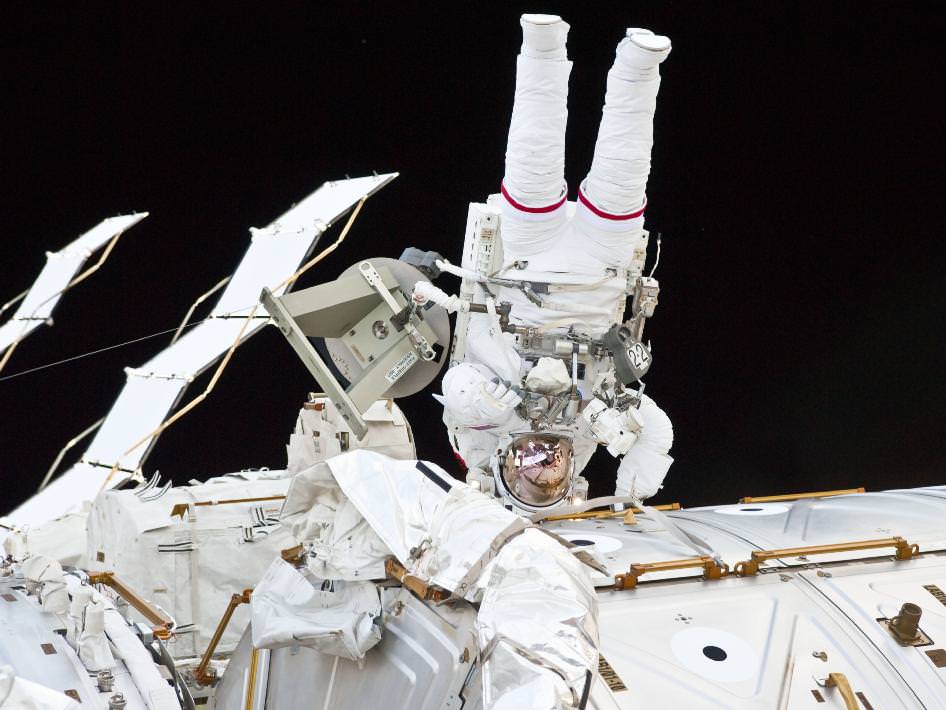Why pick up a low quality, wobbly telescope from the department store when you can craft your own – just like Galileo, and all the great astronomers from history. For a minor investment, you can build a worthy telescope out of spare parts and high quality kits.
Continue reading “Astronomy Cast Ep. 327: Telescope Making, Part 1: Toys and Kits”
Happy Holidays from Cassini!
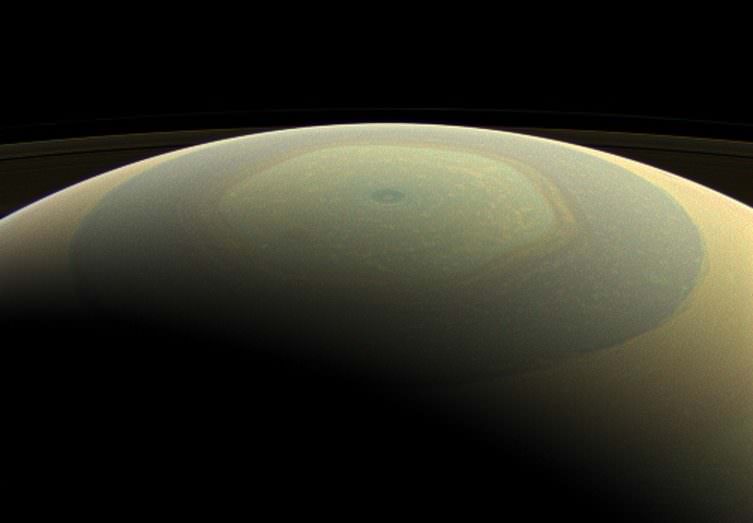
Cassini couldn’t make it to the mall this year to do any Christmas shopping but that’s ok: we’re all getting something even better in our stockings than anything store-bought! To celebrate the holiday season the Cassini team has shared some truly incredible images of Saturn and some of its many moons for the world to “ooh” and “ahh” over. So stoke the fire, pour yourself a glass of egg nog, sit back and marvel at some sights from a wintry wonderland 900 million miles away…
Thanks, Cassini… these are just what I’ve always wanted! (How’d you know?)
Saturn’s southern hemisphere is growing more and more blue as winter approaches there — a coloration similar to what was once seen in the north when Cassini first arrived in 2004:
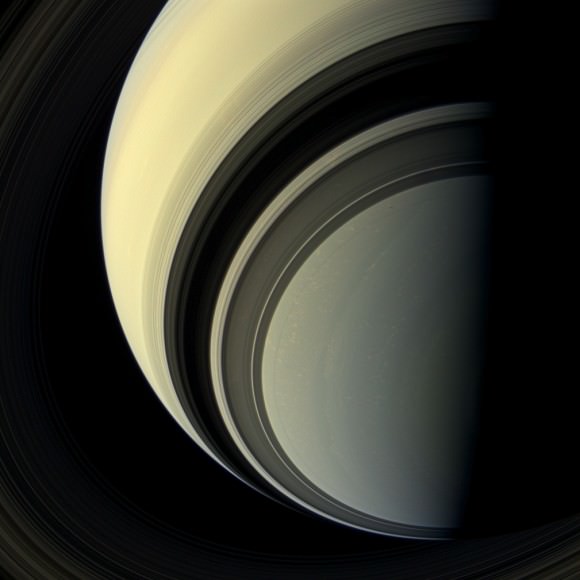
(The small dark spot near the center right of the image above is the shadow of the shepherd moon Prometheus.)
Titan and Rhea, Saturn’s two largest moons, pose for Cassini:
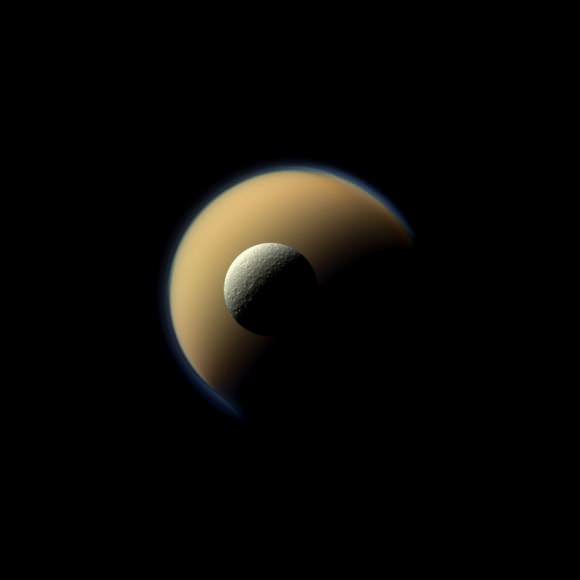
The two moons may look like they’re almost touching but in reality they were nearly half a million miles apart!
Titan’s northern “land of lakes” is visible in this image, captured by Cassini with a special spectral filter able to pierce through the moon’s thick haze:
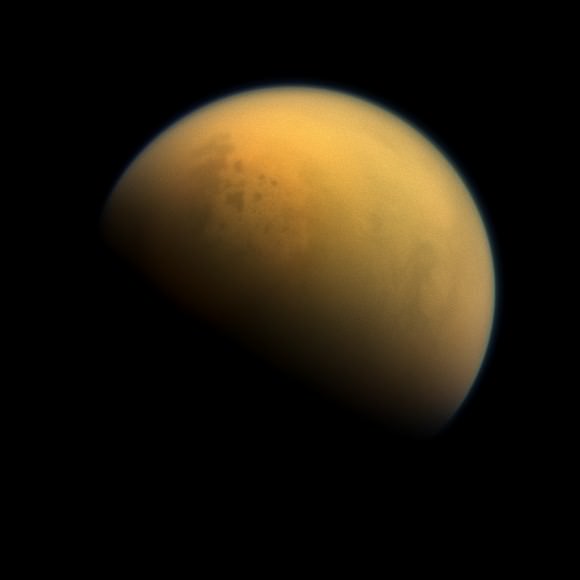
Read more: Titan’s North Pole is Loaded with Lakes
The frozen, snowball-like surface of the 313-mile-wide moon Enceladus:
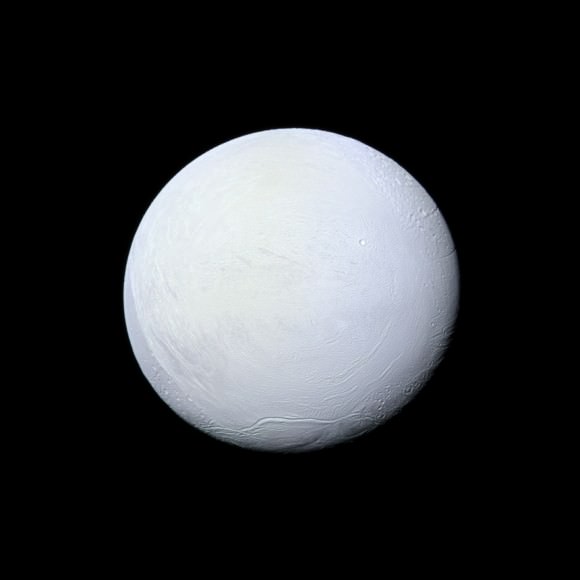
(Even though Enceladus is most famous for its icy geysers, first observed by Cassini in 2005, in these images they are not visible due to the lighting situations.)
Seen in a different illumination angle and in filters sensitive to UV, visible, and infrared light the many fractures and folds of Enceladus’ frozen surface become apparent:
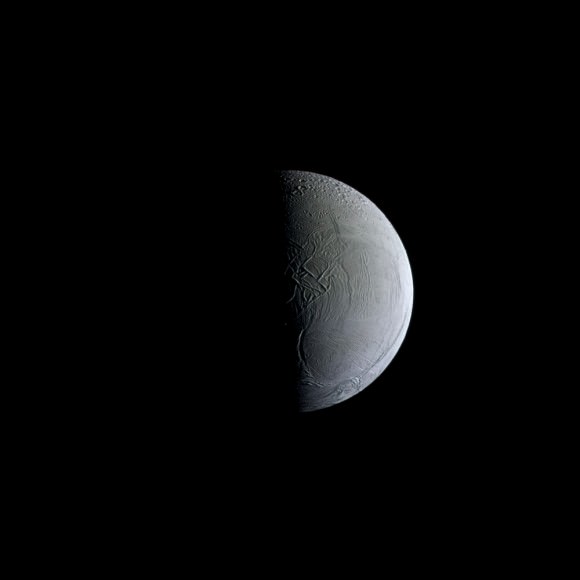
Because of Cassini’s long-duration, multi-season stay in orbit around Saturn, researchers have been able to learn more about the ringed planet and its fascinating family of moons than ever before possible. Cassini is now going into its tenth year at Saturn and with much more research planned, we can only imagine what discoveries (and images!) are yet to come in the new year(s) ahead.
“Until Cassini arrived at Saturn, we didn’t know about the hydrocarbon lakes of Titan, the active drama of Enceladus’ jets, and the intricate patterns at Saturn’s poles,” said Linda Spilker, the Cassini project scientist at NASA’s Jet Propulsion Laboratory. “Spectacular images like these highlight that Cassini has given us the gift of knowledge, which we have been so excited to share with everyone.”
Read more about the images above and see even more on the CICLOPS Imaging Team website, and see the NASA press release here.
Thanks to Carolyn Porco, Cassini Imaging Team Leader, for the heads-up on these gifs — er, gifts!
New Video Celebrates Saturn And The Day The Earth Smiled
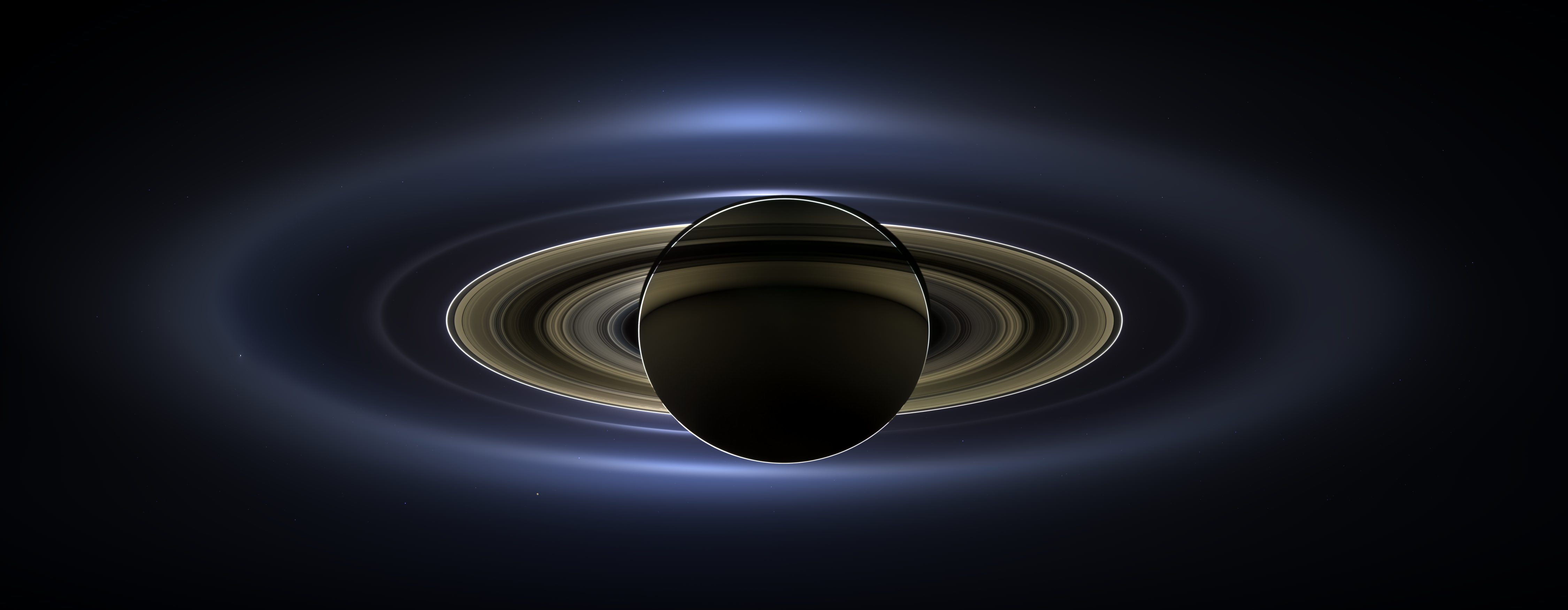
Just to demonstrate how far-reaching that Saturn snapshot of Earth this year was, the Skopje Astronomical Society (from Macedonia) made a video celebrating “The Day The Earth Smiled”, when the Cassini spacecraft looked at Earth on July 19 and thousands of people made pictures and video showing what they were doing at that time.
Watch the video, then look at some stunning pictures of Saturn below the jump.
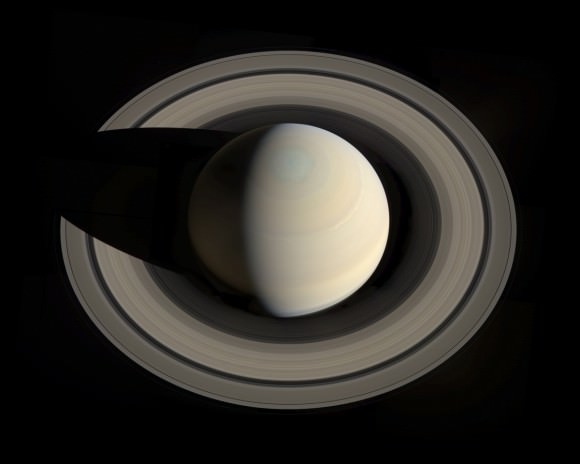
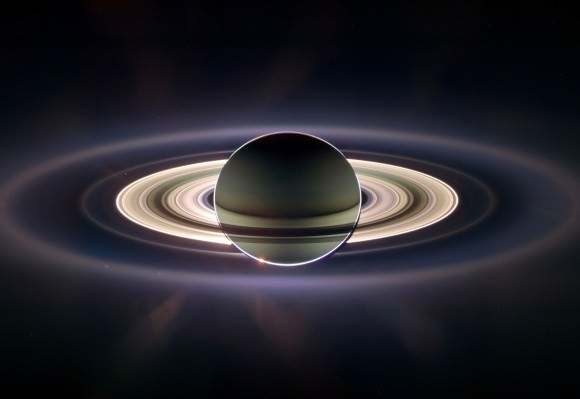
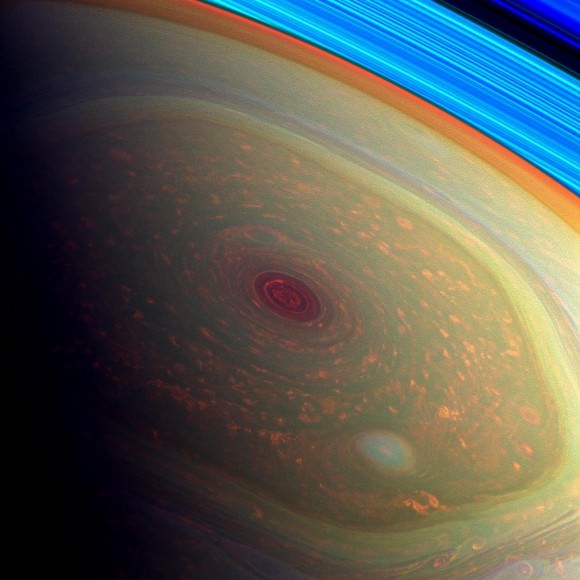
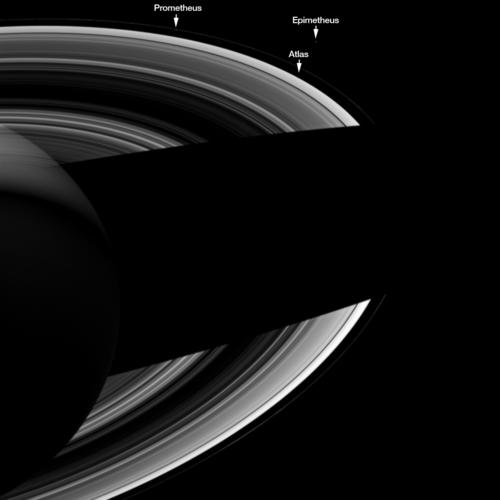
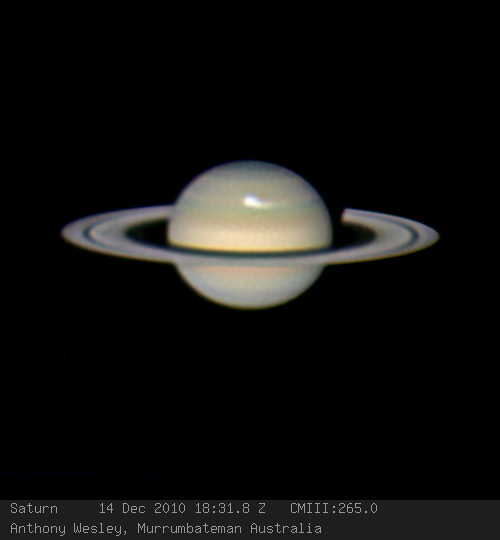
‘Tis the Season to Spot Jupiter: A Guide to the 2014 Opposition
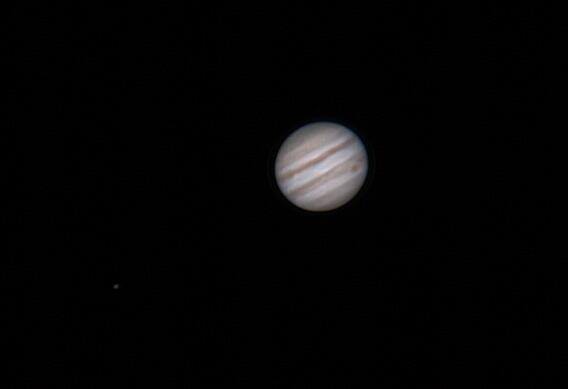
Lovers of planetary action rejoice; the king of the planets is returning to the evening skies.
One of the very first notable astronomical events for 2014 occurs on January 5th, when the planet Jupiter reaches opposition. You can already catch site of Jove in late December, rising in the east about an hour after local sunset. And while Venus will be dropping faster than the ball in Times Square on New Year’s Eve to the west in early 2014, Jupiter will begin to dominate the evening planetary action.
Orbiting the Sun once every 11.9 years, oppositions of Jupiter occur about once every 13 months or about 400 days, as the speedy Earth overtakes the gas giant on the inside track. This means that successive oppositions of the planet move roughly one astronomical constellation eastward. In fact, this year’s opposition is it’s northernmost in 12 years, occurring in the constellation Gemini. “Opposition” means that an outer planet is rising “opposite” to the setting Sun. As this opposition of Jupiter occurs just weeks after the southward solstice, Jupiter now lies in the direction that the Sun will occupy six months from now during the June Solstice.
This all means that Jupiter will ride high in the sky for northern hemisphere observers towards local midnight, a boon for astrophotographers looking to catch the planet high in the sky and out of the low horizon murk.
Jupiter will reach its most northern point for 2014 at a declination of +23.3 degrees on March 11th.
Jupiter also “skipped” 2013, in the sense that it was an “oppositionless year” for the giant world, as said 13 month span fell juuusst right, first on December 2nd, 2012 and then on January 5th, 2014. The next opposition of Jupiter will occur on… you guessed it… February 6th, 2015. The last year missing an opposition of Jupiter was 2001.
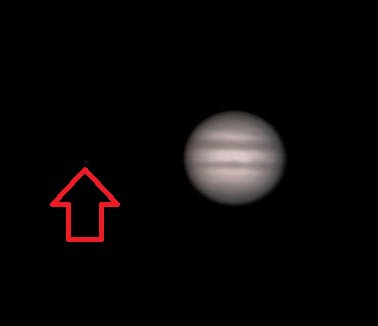
The exact timing of Jupiter’s opposition to the Sun in right ascension occurs at 21:00 UT/4:00 PM EST on January 5th. Its closest approach to Earth, however, arrives 27 hours prior, owing to a slight outward curvature of the approach of the two worlds. Jupiter will then lie about 4.21 astronomical units (AUs) or 629 million kilometres distant. This is just about down the middle of how close it can pass; Jupiter was just under 4 AUs distant in September 2010, and can pass almost 4.5 AUs from Earth, as happened in April 2005.
Jupiter also reaches a maximum brightness of magnitude -2.7 at opposition in 2014 and presents a disk 46.8” arc seconds wide. The coming month also provides a great chance to catch Jupiter in the daytime sky just before sunset, when the waxing gibbous Moon passes 4.9 degrees south of the planet on the evening of January 14th.
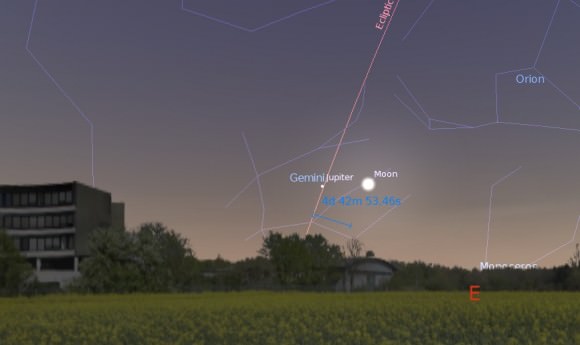
The very first thing you’ll notice looking at Jupiter, even at low power with binoculars or a telescope, is it retinue of moons. Though the planet has 67 discovered moons and counting, only the four large Galilean moons of Io, Europa, Ganymede and Callisto are readily apparent in a telescope. It’s fun to see orbital mechanics in action and watch them from night to night as they change position, just as Galileo first did over four centuries ago. This provided him with evidence that there is much more to universe than meets the eye, though we can consider ourselves fortunate that his proposal to name them the “Medician Moons” after his Medici benefactors was never widely adopted.
Crank up the magnification, and you’ll notice the large twin stripes of the northern and southern equatorial cloud belts crossing the disk of Jupiter. While the northern belt is stable, the southern belt has been known to submerge and disappear from view about every decade or so, as last happened in 2009-2010. You’ll also notice the Great Red Spot, a massive storm system over three times larger than the Earth that has been tracked by astronomers since it was recorded by Samuel Schwabe in 1831. The planet has the fastest rotation of any world in our solar system at 9.9 hours, and you’ll notice this swift rotation tracking Jupiter over the course of a single evening.
Transits and occultations of Jupiter’s moons are also always interesting to watch. The variation in the timing of these events at differing distances led Danish astronomer Ole Rømer to make the first attempts at measuring the speed of light in 1676.
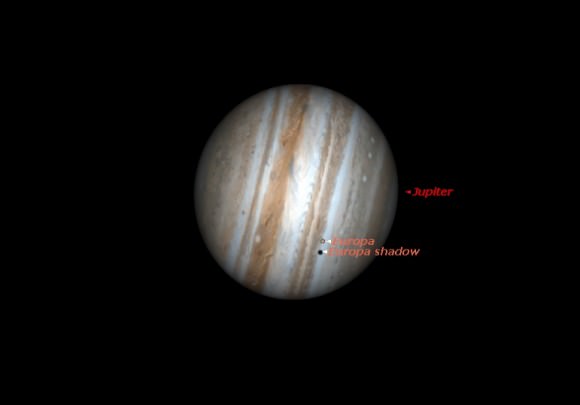
It’s interesting to note that Jupiter and its moons cast a shadow nearly straight back from our line of sight around opposition. You can see this change as the planet heads towards quadrature on April 1st, 2014 and Jupiter and its moons cast shadows off to one side. We’re also in the midst of a plane crossing, as the orbits of the Jovian moons appear edge-on to our line of sight in 2014 headed into early 2015. The outermost Jovian moon Callisto began a series of transits in 2013 and will continue to do so through 2014.
This is a great time to begin following all of the Jovian action, as we head into another exciting year of astronomy!
Groovy! Martian Moon Shows Off Its Weird Stripes In New Video
After seeing Phobos imaged from the surface of the Red Planet by Mars Curiosity, now we’re lucky to get a close-up treat: here’s a video showing Mars Express images of the Martian moon over the last 10 years. The images reveal mysterious grooves running through the small moon, which is 13.5-miles (22 kilometers) in diameter, and scientists still aren’t sure what’s going on.
“The moon’s parallel sets of grooves are perhaps the most striking feature, along with the giant 9 km-wide Stickney impact crater that dominates one face,” the European Space Agency wrote.
“The origin of the moon’s grooves is a subject of much debate. One idea assumes that the crater chains are associated with impact events on the moon itself. Another idea suggests they result from Phobos moving through streams of debris thrown up from impacts 6000 km away on the surface of Mars, with each ‘family’ of grooves corresponding to a different impact event.”
For more about amazing discoveries from Mars Express, check out our top 10 list from the summer!
Cue The Aww: Astronaut Puts 3-Year-Old Son’s Drawing On A Quilt Piece

Kids’ drawings are the best, as astronaut Karen Nyberg proudly shows in her latest mini-quilt piece. The astronaut — who just spent six months in orbit during Expedition 36/37 — is also a prolific quilter and drew inspiration from her son, three-year-old Jack, in this quilt posted on Pinterest. The drawing shows how quickly Jack changed during her mission, she wrote.
“When I left for space station in May, my son was drawing only lines, circles, and squiggles. When I returned in November, he was drawing people. He told me this picture is ‘Jack playing in the grass on a sunny day.’ ”
We’re guessing Nyberg is having an easier time quilting now that she isn’t working in microgravity anymore. The video below explains the challenges she had doing quilting in orbit and making sure that sharp pins didn’t just float away and cause problems on station.
Nyberg is married to astronaut Doug Hurley (who piloted the final shuttle mission, among other things) and as the Houston Chronicle’s Eric Berger points out in November, the parents have lots of experience helping each other out with child care during training and missions.
China’s 1st Lunar Lander snaps 1st landing site Panorama
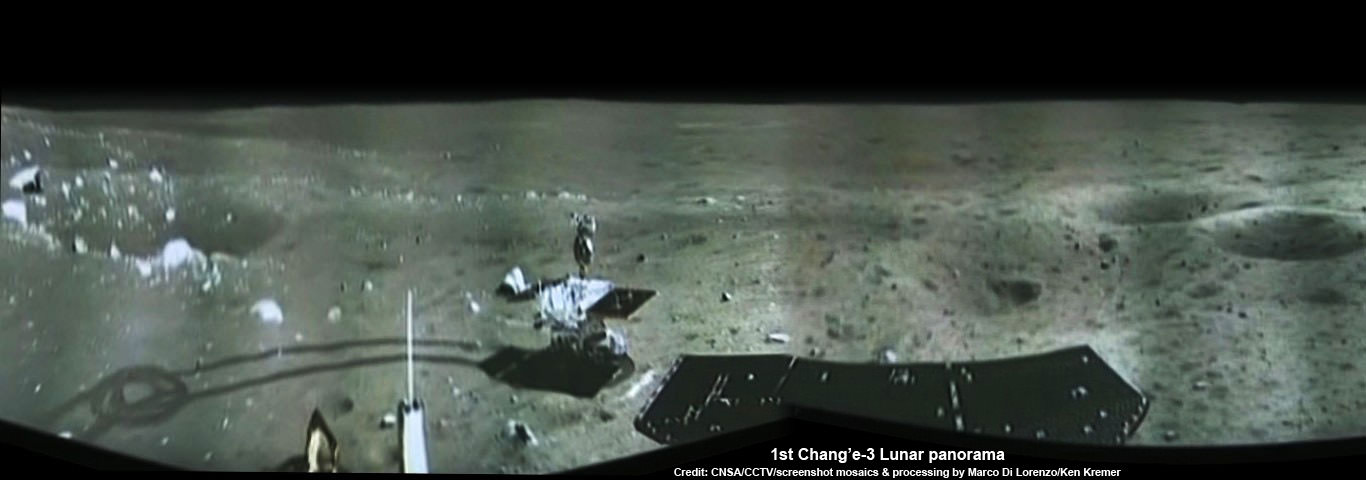
Portion of 1st panorama around Chang’e-3 landing site after China’s Yutu rover drove onto the Moon’s surface on Dec. 15, 2013. The images were taken by Chang’e-3 lander following Dec. 14 touchdown. Panoramic view was created from screen shots of a news video assembled into a mosaic. Credit: CNSA/CCTV/screenshot mosaics & processing by Marco Di Lorenzo/Ken Kremer
See the complete panorama below
Story updated[/caption]
China’s inaugural Chang’e-3 lunar lander has snapped the missions first panoramic view of the touchdown spot at Mare Imbrium.
Chinese space officials have now released the dramatic surface imagery captured by the Chang’e-3 mothership on Dec. 15, via a video news report on CCTV.
To make it easier to see and sense ‘the new view from the Moon’, we have created screen shots from the rather low resolution TV broadcast and assembled them into a photo mosaic of the landing site – see above and below mosaics by Marco Di Lorenzo and Ken Kremer.
The Chang’e-3 mothership imaged the stark lunar terrain surrounding the spacecraft after the ‘Yutu’ rover perched atop successfully drove all six wheels onto the moon’s surface on Dec. 15, barely 7 hours after the momentous landing on Dec. 14.
The individual images were taken by three cameras positioned around the robotic lander.

Chinese scientists then pieced them together to form the lander’s first panoramic view of the lunar surface, according to CCTV.
“This picture is made of 60 pictures taken 3 times by the rover. The rover used three angles: vertical, 15 degrees tilted up, and 15 degrees down…so that we get an even farther view,” said Liu Enhai, Designer in Chief, Chang’E-3 Probe System, in a CCTV interview
The panoramic view shows ‘Yutu’ and its wheel tracks cutting a semi circular path at least several centimeters deep into the loose lunar regolith at the landing site at Mare Imbrium, located near the Bay of Rainbows.
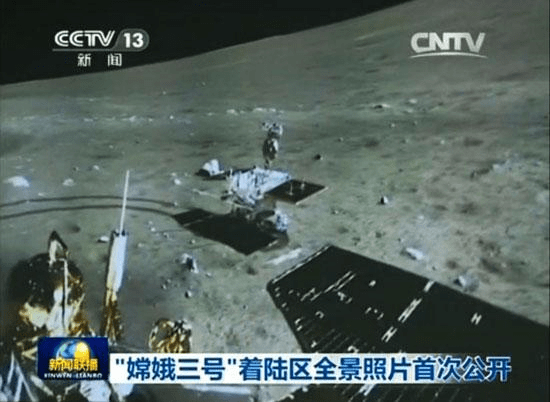
A significant sized crater, several meters wide, is seen off to the left of Yutu and located only about 10 meters away from the Chang’e-3 lander.
Several more craters are visible in the pockmarked surface around the lander.
Mission leaders purposely equipped the lander with terrain recognition radar and software so that it could steer clear of hazards like craters and large boulders and find a safe spot to land.
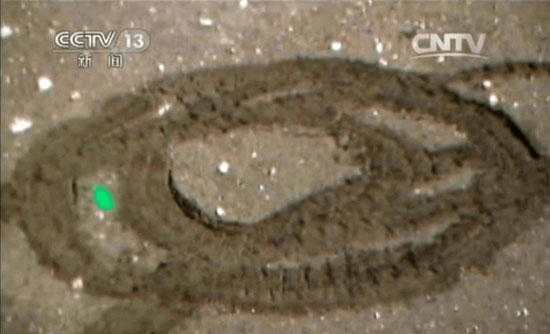
Indeed just prior to touchdown, the lander actually hovered at an altitude of 100 meters for about 20 seconds to avoid the craters and rock fields which could have doomed the mission in its final moments.
See the dramatic Chang’e-3 landing video in my earlier report – here.
Here is our annotated screen shot from the landing video showing the eventual landing site in the distance:
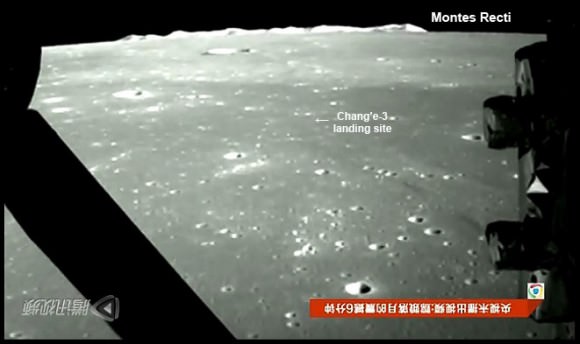
The 140 kilogram Yutu rover then turned around so that the lander and rover could obtain their first portraits of one another.
“The rover reached the point of X after it went down from the lander, then it established contact with the ground. Then it went to point A, where the rover and lander took pictures of each other. Then it reached point B, where it’s standing now.” said Liu Jianjun, Deputy Chief Designer, Chang’E-3 Ground System, to CCTV.
China thus became only the 3rd country in the world to successfully soft land a spacecraft on Earth’s nearest neighbor after the United States and the Soviet Union.
Chinese President Xi Jinping and space agency leaders have hailed the Chang’e-3 mission as a complete success for China.
The Yutu rover, which translates as ‘Jade Rabbit’ will use its science instruments to survey the moon’s geological structure and composition on a minimum three month mission to locate the moon’s natural resources for use by potential future Chinese astronauts.
The lander will conduct in-situ exploration at the landing site for at least one year, say Chinese officials.
Hopefully, China will quickly start releasing full resolution imagery and video taken by the Chang’e-3 lander and Yutu rover at a dedicated mission website, like NASA does, rather than issuing photos of imagery from projection screens and televisions – so that we all can grasp the full beauty of their tremendous lunar feat.
Stay tuned here for Ken’s continuing Chang’e-3, LADEE, MAVEN, MOM, Mars rover and more news.
Ken Kremer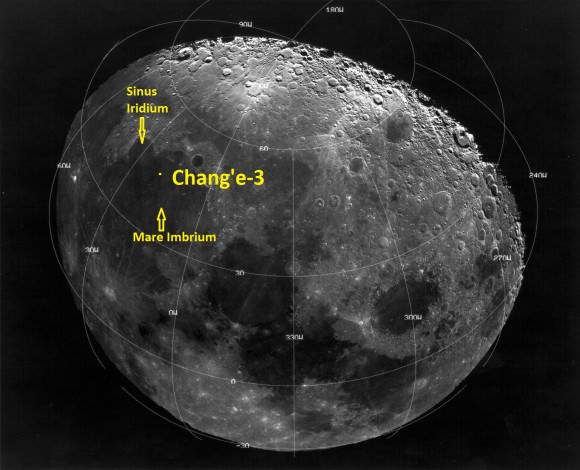 Landing site of Chinese lunar probe Chang’e-3 on Dec. 14, 2013. [/caption]
Landing site of Chinese lunar probe Chang’e-3 on Dec. 14, 2013. [/caption]
Speedy Spacewalkers Ahead Of Pace As Next Repair Moved To Tuesday

The ghosts of spacewalks past did not haunt the quick-working pair of astronauts who began replacing a faulty ammonia pump on the International Space Station today (Dec. 21).
Unlike a difficult spacewalk to do a similar repair in 2010, NASA astronauts Rick Mastracchio and Mike Hopkins were so far ahead of schedule that they began doing tasks scheduled for the second in their expected trio of spacewalks.
In better news yet for the spacewalkers, a water leak in Hopkins’ spacesuit this past July — one that sent astronauts scrambling back to the airlock for safety — did not happen again, showing that the part replacement NASA directed had worked. An unrelated water issue in Mastracchio’s suit, however, made agency officials decide to delay the next spacewalk one day to Dec. 24.
The pump replacement is needed to put the space station at full fighting weight. Since Dec. 11, science experiments and other non-critical systems have been offline since a valve in the pump broke. While the astronauts are in no immediate danger, one of their two cooling loops is shut down and there is not a big margin of safety if the other loop fails.
Since this is NASA’s first spacewalk since the leaky suit was last used, the agency emphasized two new measures it has to protect the astronauts if another leak occurs. The first is a new helmet absorption pad (HAP) to soak up any water in the helmet. The second is a pipe — a snorkel — that would let astronauts breathe air from another part of the suit, if required.
But with every “HAP check” that CapCom and astronaut Doug Wheelock called up to the astronauts today, they reported that the suits were dry and everything was fine. The new water issue happened after the spacewalk, while the astronauts were repressurizing the airlock. In a statement, NASA said water could have entered Mastracchio’s suit sublimator and decided to switch him to a backup suit as a precaution.
The spacewalk tasks themselves, however, went far more swiftly than problems Wheelock experienced in 2010, such as when an ammonia line on the pump refused to unhook as required and caused a lengthy delay. NASA made some changes (such as lowering the pressure on the lines, as Wheelock told Universe Today), and this time, Mastracchio powered through the line and electrical removals. The astronauts quickly moved 1.5 hours of schedule and then beyond. A few stray ammonia flakes hit Mastracchio’s suit, but not enough to cause concerns about contamination since the traces of substance baked off in the sun as he worked.
“I don’t know if you believe in miracles, but I got it on the first try,” Mastracchio radioed early in the spacewalk as he got a tricky part of a Canadian robotic arm foot restraint threaded. Mastracchio rode the arm for much of the spacewalk while Hopkins was the “free floating” colleague hovering and doing other tasks nearby.
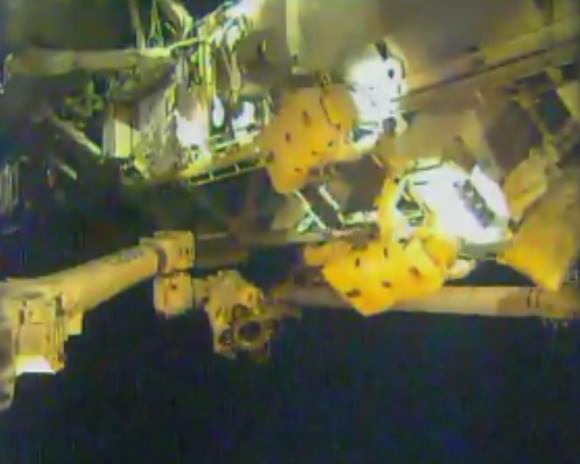
The most spectacular television shots occurred towards the end of the five-hour, 28-minute spacewalk when Mastracchio carefully wrestled the 800-pound ammonia pump module out of its spot on the space station while riding aboard Canadarm2. (Controlling the arm was Japanese astronaut Koichi Wakata, guided by CapCom and fellow Japanese astronaut Aki Hoshide on the ground.)
After he stowed the module, Mission Control gave the astronauts the go-ahead to put in the spare. Mastracchio, however, said he felt it was best for the astronauts to leave it for next time. While the pair have three spacewalks (including today’s) slated to finish the task, it’s possible they could wrap it up in two — but only if things go as smoothly as this time.
The next spacewalk will take place Dec. 24 at 7:10 a.m. EST (12:10 p.m. UTC), and will be available on NASA Television. We’ll keep you up to speed as the next spacewalk occurs. Today’s excursion was Mastracchio’s seventh and Hopkins’ first.
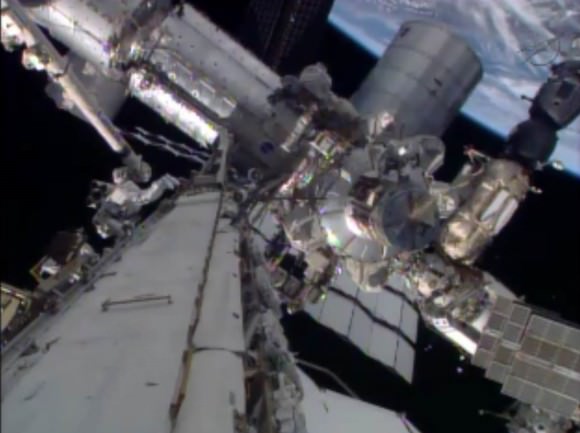
Hubble Looks but Finds No Trace of Comet ISON
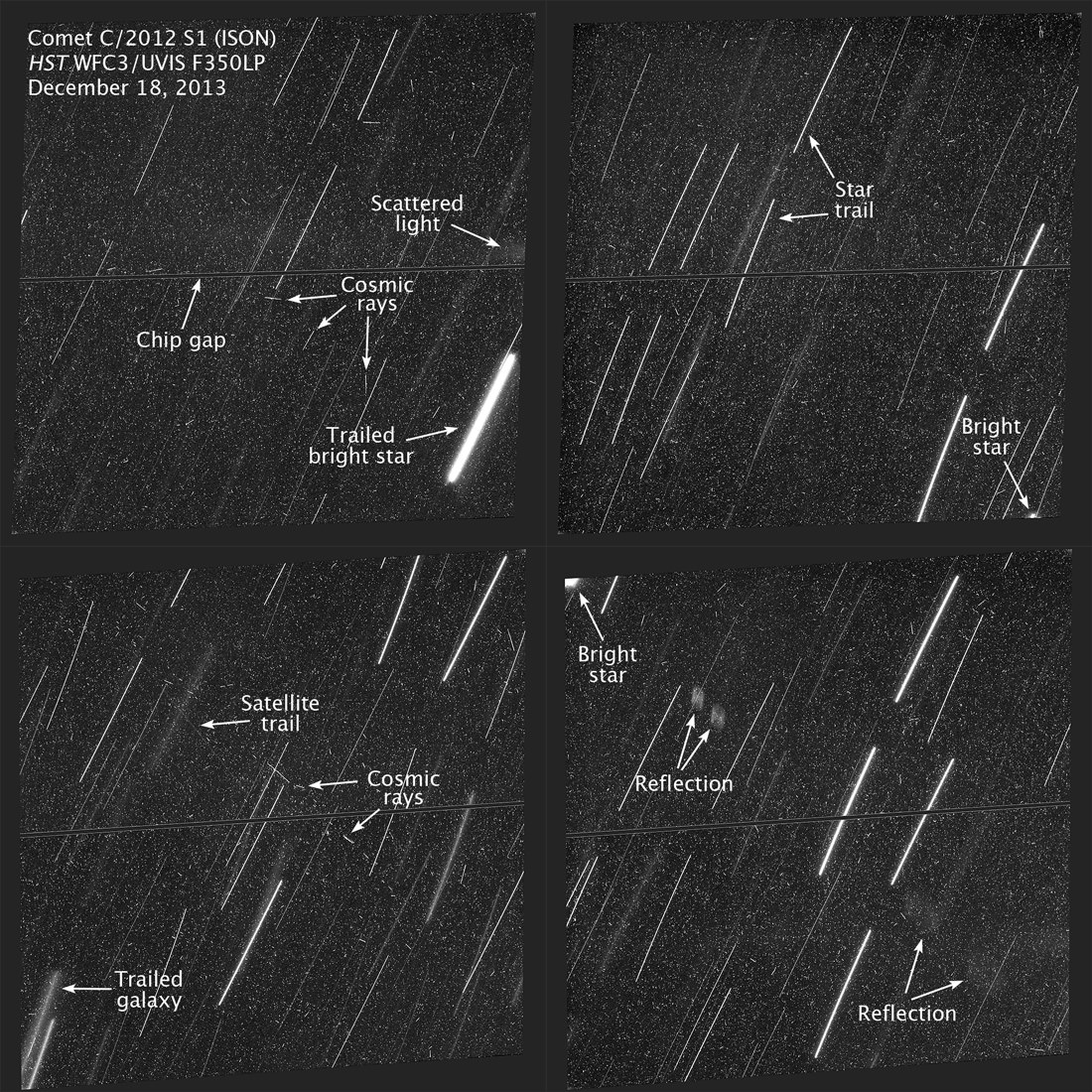
On December 18, the Hubble Space Telescope slewed to Comet ISON’s expected position and found nothing down to the incredibly faint magnitude of 25. According to astronomer Hal Weaver, who planned the ISON search, that limit implies any remaining fragments would have to be smaller than about 500 feet (160 meters) in diameter.
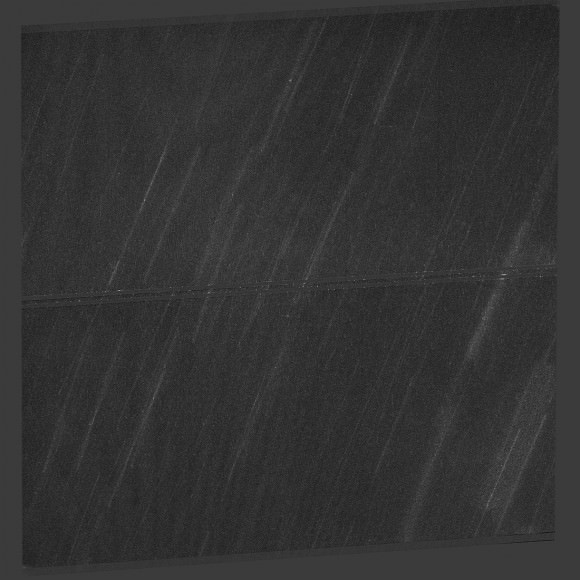
Nothing is visible in any of the images in the photo panel except trailed stars and galaxies, reflections and the occasional zap of a cosmic ray. After ISON was torn asunder by the sun, there existed the possibility that comet’s remains would follow a slightly different orbit. To make sure he was covered, Weaver photographed two separate comet positions, stacking several exposures together.
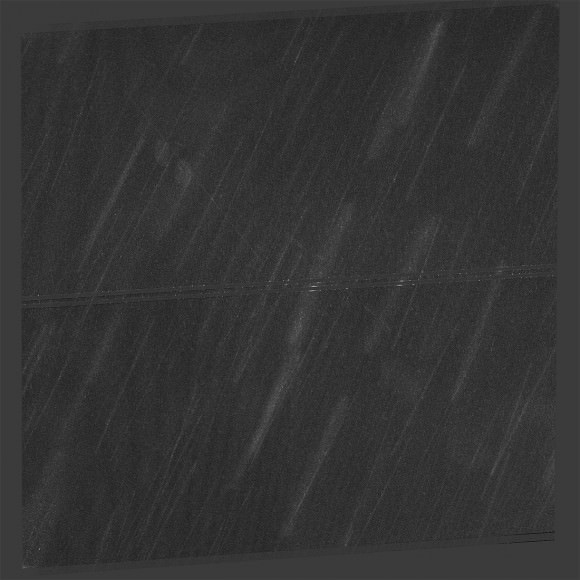
“The images have been combined so that features not at the same place in the various images are suppressed. Any comet fragments would show up more clearly in this composite, though stars still show up as faint streaks”, writes Zolt Lavay, author of the ISONblog at the Hubble site.
Again, nothing shows up in these either. While no one can say that ISON has completely disappeared, we now know that at the very least it’s broken into pieces too small for even Hubble to see. What was once a beautiful sight in binoculars has expanded into a vast cloud of gas and dust thinner than Ebenezer Scrooge’s gruel.
Watch Live As Astronauts Fix The Space Station Saturday
There’s a cooling problem on station, and two astronauts are ready to head outside to fix it. NASA astronauts Rick Mastracchio (a six-time spacewalker) and Mike Hopkins (a rookie) are expected to spend 6.5 hours “outside” starting at 7:10 a.m. EST (12:10 p.m. UTC) on Saturday. On robotics will be Japanese astronaut Koichi Wakata, who has operated every bit of robotics currently on station.
Click to watch Expedition 38’s crew action live above. (If for some reason the stream is not working, an alternate link is available here.) We’ll have full coverage of the spacewalk after it happens, too.
For a walkthrough of what’s going to happen, NASA handily provided a video that you can see below the jump. We also have links to all of our coverage so far.
In a nutshell, here’s what happened: a cooling loop shut down automatically on station Dec. 11 when the loop got too cold. NASA traced the problem to a faulty flow control valve inside of the pump. As agency officials prepared for a spacewalk just in case, NASA attempted to fix the valve and then control an alternate one from the ground.
However, the station is entering a time when there will be a lot of sun shining on it, making dockings and spacewalks difficult. To be prudent, NASA decided to do a spacewalk now and replace the pump. To keep the astronauts safe if another spacesuit leak happens again, the agency has introduced soaker pads and snorkels to the spacesuits.
Here’s what’s going to happen during the three spacewalks that are scheduled for Saturday, Monday (Dec. 23) and if necessary, Wednesday (Dec. 25), according to lead U.S. Spacewalk Officer Allison Bolinger:


